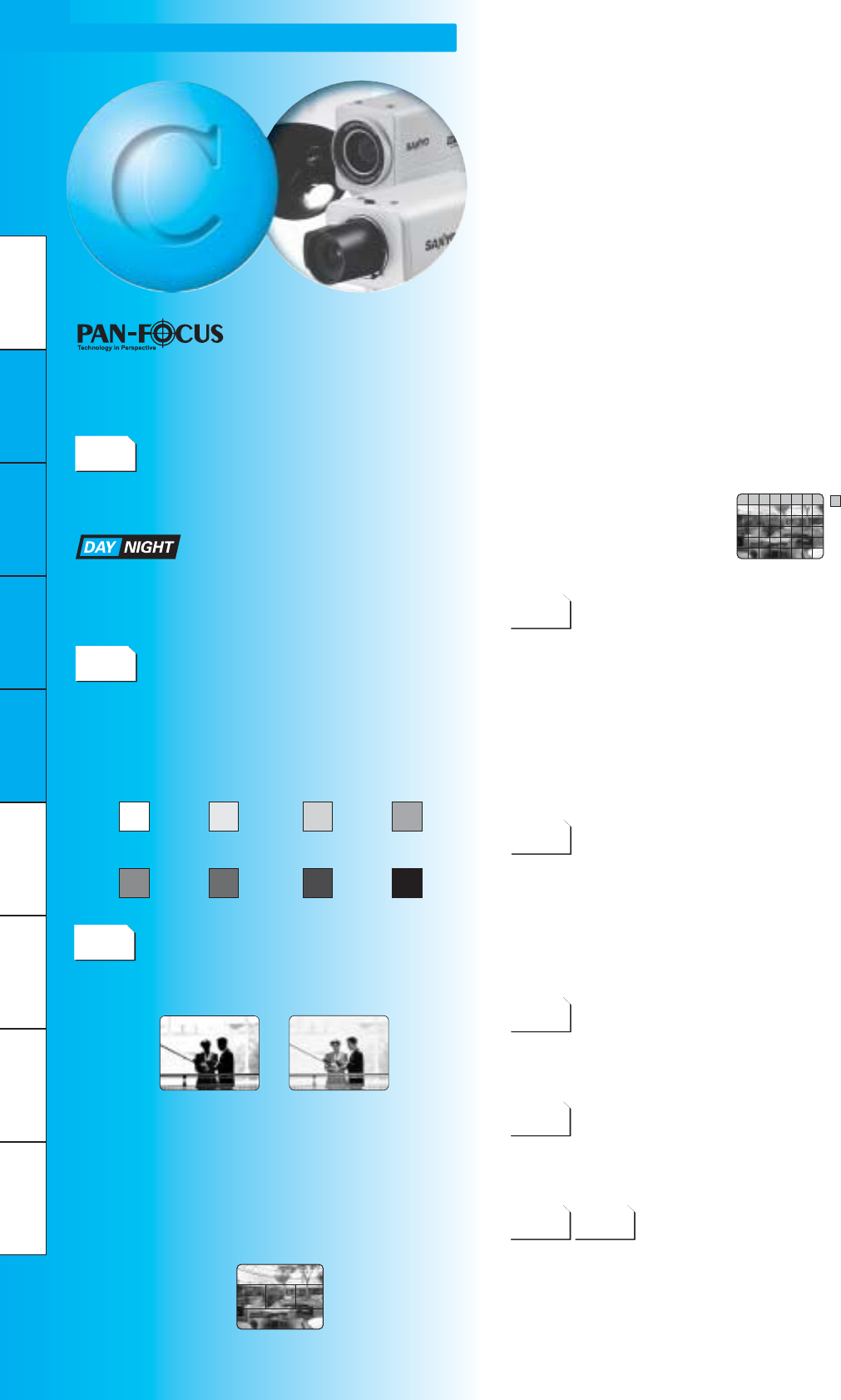
*Approximate values
Outdoors with fine weather
100,000 to
5,000 lx
5,000 lx 1,500
to 750 lx
5
to 3 lx75 to 30 lx 0.3 to 0.1 lx2 to 1 lx
Fine weather in the shade,
library reading rooms
outdoors with cloud weather
Shops, food counters,
200 to 100 lx
Hotel reception
areas
Theater seatingCar parks,
warehouses
Hospitals at night Full moon
Illumination guidelines
Without backlight
compensation
Subject appears as a
silhouette against
bright background.
With backlight
compensation
Subject appears
clear and sharp
Areas in which
illuminance will
not be measured
An example of weight setting:
Top = 1, Bottom = 5, Left = 10,
Right = 10, Center (fixed) = 15.
The size and position of the
Center area is adjustable.
1
1515 1010
1010
5
1
15 10
10
5
*Images used may differ slightly from actually recorded scenes.
Camera
A Comprehensive Line-up
of Multi-functional High
Resolution Cameras
Solves a Variety of
Surveillance Needs
520
TV Lines
Minimum
illumination
0.03 lx
Multi-spot /
Center-zone
BLC
Backlight compensation
When filming in directions with backlighting such as entrance
ways or windows where the backlighting causes the subject to appear as
a silhouette, this function automatically adjusts to the most appropriate
aperture.
SANYO CCD cameras use four systems: center-zone photometry
system, 5-section photometry mode setting, multi-spot photometry (48 /
64-section) systems and multi-spot masking.
With the
center-zone photometry
system, the brightness of the light
measuring area is measured, and by automatic adjustment of the lens
aperture, a clear and sharp image is possible even when the subject is
backlit.
With this system, the light measuring area is in the center of the screen
for an optimal image of the subject.
With the 5-section
photometry system, the
screen is divided into 5
sections to which the user
will assign 15-scale weights. The brightness of the picture will be kept at
optimum by giving priority to the area with the higher weight. (A DC type
auto-iris lens is required to enable this mode.)
With the multi-spot photometry (48/64-section) system, the screen is
divided into 48 / 64 areas on which luminous intensity is measured
separately to determine the lighting/backlight conditions of all objects.
This makes it possible to apply optimum backlight compensation even for
peripheral and moving objects.
With the multi-spot masking (48-sections) system, certain areas can be
eliminated from the photometric
measurement using a 48-section
grid. The light intensity for the
remaining area is measured and the
image brightness is adjusted
accordingly.
White-balance (color cameras only)
Sometimes the color of clothes seen under lighting inside a
shop appears different when viewed in sunlight outside. This is due to
variation in the color temperature of the light source. The human eye is
highly adaptable to variation in the color temperature of light sources so
that even when the light source changes, white appears as white. But
CCD adaptability is poor, and to reproduce unbalanced white when the
light source changes, correction of the image signal is necessary.
All SANYO color CCD cameras have TTL (Through The Lens) auto tracing
white-balance, so even in a location with significant variation in color
temperature of the light sources, such as next to a window, the image is
automatically adjusted accordingly to achieve the best color.
Synchronizing system
This is the timing used by the security camera when filming
(synchronizing). There are sync systems that synchronize with the
internal sync signal circuit (internal sync.), or that synchronize with a sync
signal input to the security camera from outside (external sync.), or those
that use the cycle of the camera's AC power to synchronize (line lock).
When switching between several security cameras for surveillance using
one monitor, synchronizing the cameras is necessary. For this, the line
lock and external sync systems are used.
SSP (RS-485) compatible
By using SSP (SANYO Security Serial Protocol), cameras
and DVRs can be controlled with just one controller over a daisy chain
connection up to a maximum of 254 devices. The maximum cable
length (total length of the daisy chain path) is 1200 m (4000 feet).
Iris
The aperture that is adjusted to control the amount of light
entering the lens depending on the lighting conditions. If the lighting
is consistent, a fixed exposure is used; if the lighting fluctuates, auto-
exposure uses is used.
Power Sources
The power sources for driving the camera.
Pan-focus lens can bring a broad area into
focus, enabling the camera system to
visualize everything in the field of view clearly at the same time. The
lens also has a 2.6x zooming function. As a result, it allows a
surveillance camera to capture a clear video image offering details of
background objects.
Horizontal resolution
The SANYO camera delivers 520 TV lines.
The DSP
(Digital Signal Processor)
with a proprietary algorithm
produces sharp outlines and natural color with no color smudges.
24-hour surveillance is now possible with just a
single camera that works as a color camera during
the day and a high-sensitivity B/W camera during the night. The mode
of operation is automatically switched by replacing the optical filter.
The use of an optical filter in the color mode also allows video
recording in true colors.
Minimum subject illumination
The minimum illumination required for recognizing a subject
is generally 2 to 6 lx for color cameras, and 0.03 lx for B/W cameras.
Minimum subject illumination changes according to the F value of
combined lenses. When F1.2 lenses and F1.4 lenses are combined with
an F1.2 lens, minimum subject illumination is reduced, making
monitoring possible in dark locations.
SSP
Internal sync.
External sync.
Line lock
24V AC
12V to
15V DC
220V to
230V
Electronic
iris
ATW
AWC
Manual
5
Camera Technology
System Chart
Specialty Camera
Network Camera
Pan-focus Camera
Camera · Lens
DVR
SSP System
Example System
Monitor


















